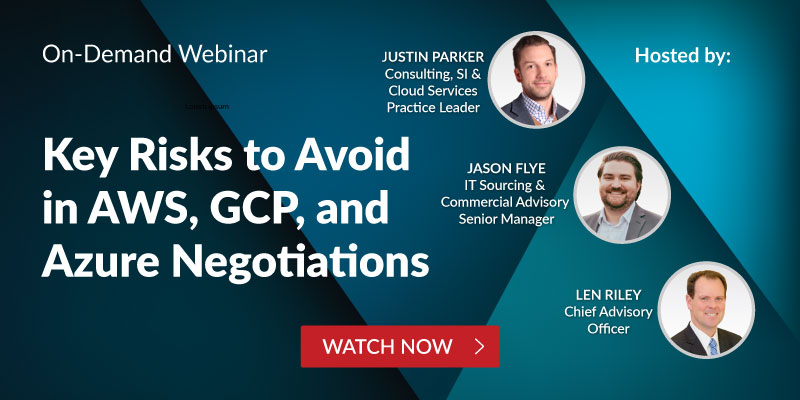- Greg Hall
- Reading Time: 6 minutes

In the SAP SI selection process, the traditional approach facilitated by procurement is flawed and fails to account for the complexities of an enterprise SAP SI selection. Here’s how to get it right.
There is so much to learn from failed SAP implementations, but one of the most important involves system implementation provider (SI) selection. Indeed, I have seen a direct correlation between SAP SI failures and how companies approach the SI selection process.
The traditional procurement approach is no longer appropriate for a number of reasons, including the evolution of the hosting market (specifically the hyperscalers), SAP’s RISE offering, and the many pivots SIs have had to make to keep their seat at the table with companies. Objectively understanding your sourcing options, the benefits and risks that come with each option, and leveraging leading-edge best practices, will put you in a better position to be able to make these evaluations and ultimately make the right selection.
In your consultant selection, you must ensure your selected SI has:
- Industry experience and industry-specific tools
- Strength of the proposed SI core team members
- Technical depth and bench strength of resources
- Competency balance
- Situational awareness
- Proactive communicators
Understanding the software product and ensuring that there’s a competency balance between what the SI brings to the table versus your own internal talent is most important. You also want the SI to bring a situational awareness, meaning that they can prove that they’ve done these kinds of projects before. The SI also needs to be proactive in communications. They should not only identify issues for you, but they should give you the lead time necessary to make big decisions on these projects.
Let’s take a closer look at four critical success factors:
Insights for IT Negotiations · 4 Success Factors for Selecting an SAP SI Provider
Engaging Executives
SIs will never invest more in your company than they do prior to securing the signed contract to implement your SAP solutions. Because of this, you’ll need to start with executive-level engagement—not just engagement with Procurement—and continue with cross-functional engagement between your business, IT, and SI counterparts as you vet your requirements and your approach to implement (e.g., agile, big bang, or phased).
An SAP implementation is extremely complex and has impacts across all areas of your business, especially when you are looking at implementing or replacing your finance apps, purchasing apps, and supply chain apps. Implementation failures come with a high degree of risk, so setting realistic timelines up front conditions you and your SI for the complexity. You may have anticipated an 8 to 12-week process pre-project, but now realistically see it as a 3 to 4-month process. View this as a change management process and push the organization to a unified understanding.
This executive engagement affords the opportunity to communicate your program objectives and your desired outcomes at an executive level and offers you the ability to support that with cross-functional engagement with your lines of business and your IT counterparts with your prospective SI’s (think hyperscalers). You need this cross functional team to drive the change management process with support from your procurement team.
This dual-path approach comprised of executive-level engagement at the outset coupled with a well thought-out briefing by your cross functional team and your procurement organization really does provide an understanding of the objectives and scope. These leading practices demonstrate the critical nature of the program to your organization, and it sets an expectation for your prospective partners that they need to respond holistically and in kind.
Qualifying Prospective SIs
The traditional practice of 3-4 hour oral presentations may work for many requests for proposal (RFPs), but an SAP implementation is complex, often impacting multiple departments within an organization just for SAP core capabilities (e.g., order to cash, record to report, etc.). With SAP implementations, companies often also need to address transformation support for satellite/supporting capabilities like Hybris, Ariba, Concur, Fieldglass, C/4HANA, and S/4HANA. The tower leaders within these areas each have specific requirements, expectations, and objectives that need to be communicated and aligned with each SI. Building time in to address these is of utmost importance and will enable you to discuss and resolve any gaps identified in the SI’s response.
Leveraging your initial post-RFP response oral presentations to determine your down-selections is still a best practice. However, once you’ve downselected to your final 2, dedicating a full day for each SI allows you to ensure that they’re getting to know your tower leaders (and you, theirs) and finding out what’s important, what motivates you, and what success means to each and every one of you. This is an excellent opportunity to engage in deep dialog with your SI counterparts that will lead your transformation. These tower-centric workshops allow you to move from having a limited working team to a more intense business engagement. An executive presence is, again, essential, where you’re working in concert with your SI peer in each of these areas.
On your path to selecting the SI that is the right fit for your organization, you’re allowing that exchange both at an executive-level and at a tower level, affording all line-of-business groups the time necessary to get to the heart of the evaluation of their approach.
Use these workshops to further assess the team each SI has assembled. You will find that aside from the quantitative approach in your traditional process where you’re limited in your ability and your engagement, a qualitative evaluation of your vendors is a best practice. As you conclude these workshops you will find out the answers to these questions and feel confident in their responses:
- Do they have extensive experience within your industry?
- Can they prove it with examples?
- Do they understand your business?
- Do they appreciate where your deficiencies are with your resources?
- Are they complementing those deficiencies with their own resources or are they doubling down where you already have strengths?
Assessing the Proposals
In the traditional procurement-driven process, assessing the proposals begins with a cost comparison and identifying the price points associated with each of your RFP proposal responses. Avoid this comparison at this time.
While it may feel like a natural way to look at responses from a financial lens first, you should first start with assessing two things: the completeness of the proposals. Have all aspects of your request been addressed within each response? If not, notify your provider of the incomplete response and allow limited time for them to close the gap.
Then, once you have complete responses from all providers, assess how each response has addressed all aspects of your scope. Did they respond to all aspects of the proposal? Identify what elements in each response are deemed in-scope and out-of-scope. This allows you to compare responses in an apples-to-apples manner.
As an example, all provider responses may include data conversion, but you need to determine what each provider is including in data conversion. You must go deeper into these evaluations and compare and contrast your proposals. You may find out that one vendor is doing data conversion, but it’s only the set up and maybe the execution of legacy data, and not the QA and the testing.
Ensure that everyone is bidding on the same scope, and that everyone has the same assumptions relative to complexity and accountabilities. Are they taking responsibility or are they placing that responsibility on you? Instead of just evaluating price, analyze each provider’s risk profile. The SIs are naturally going to take risks to win the business, but the question is, how much risk are they actually taking when they provide the proposal?
Partner and Solution Alignment
The last key aspect of your SI evaluation has to be focused on the alignment of roles—not just between you and your SI, but a full view of your partners and solution alignment. Taking a more holistic approach is imperative because an SAP implementation is a program and not just individual events of an SI engagement and an SAP purchase. There is a cross-solution alignment that needs to be put together that addresses not only your SI participation but any third party they may require as part of their proposal.
In addition, you need to assess which provider(s) is reliant on SAP resources and in what areas and to what extent. And you need to consider the support you will need from your first release through your last. What support is being offered by your SIs and who will support you once your implementation is successfully completed? Consider both your incumbent support as well as how your support will change with the introduction of your SAP rollout and what infrastructure needs you will have as they relate to implementing your SAP solution.
Next, instead of creating a project RACI, create a program RACI. RACI stands for responsible, accountable, consulted, and informed. A RACI chart is a matrix of all the activities or decision-making authorities undertaken in an organization set against all the people or roles. A RACI helps to clearly articulate and remove uncertainty relative to responsibilities, accountabilities, and contributions. You’re helping to understand who is responsible and accountable between the organizations that are helping you deliver your solution. You’re looking to evaluate your SI’s level of commitment to act as the master conductor.
Instead of looking at a project-based SI RFP timeline, you’re really addressing an integrated sourcing strategy and looking to determine how all of these sourcing activities need to be packaged, positioned, timed, and integrated in such a way that you are making decisions as you build on your knowledge and understanding of your scope and implement an approach.
Following these best practices outlined above will position you to make the best selection for your organization and avoid making the mistakes that often lead you down of path of poor decision making.
Post a comment below, find my other UpperEdge blogs and follow UpperEdge on Twitter and LinkedIn. Learn more about our IT Services Sourcing and Negotiation Support.
Reprinted with permission. © IDG Communications, Inc., 2021. All rights reserved.

